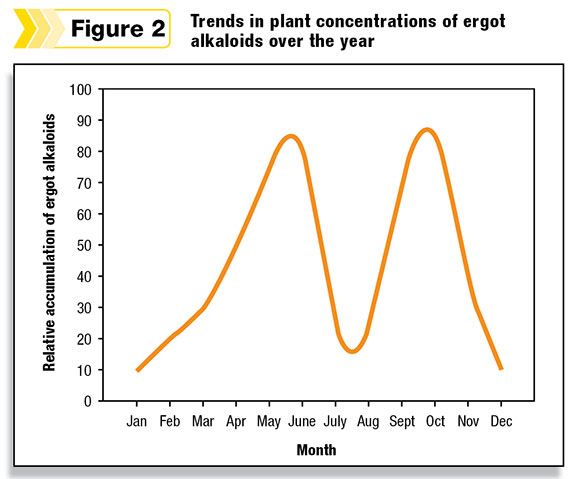Tall fescue is a cool-season perennial grass that is productive and well adapted to the soils and climate in a region of the U.S. commonly called the “fescue belt.” See Figure 1.
The grass has a real advantage in that it is persistent under low management, which has been attributed to a fungal endophyte that infects most fescue plants and produces alkaloids that provide tolerances of fescue to heat, drought and grazing stresses.
 Unfortunately, the endophyte also produces ergot alkaloids that can induce a toxicosis in cattle.
Unfortunately, the endophyte also produces ergot alkaloids that can induce a toxicosis in cattle.
Symptoms of “fescue toxicosis” are increased body temperature and respiration rate, rough hair coats during the summer months, hormonal imbalances and a reduction in forage intake.
Cow herds grazing endophyte-infected tall fescue can have reduced calving rates, milk production and weaning weights.
Average daily gains of stocker calves grazed on endophyte-infected tall fescue are typically very low, particularly in warmer temperatures and humidity.
Nutrient deficiencies from low intake by cattle exhibiting signs of toxicosis are also of concern. Consequently, ergot alkaloids produced by the toxic endophyte annually cost the U.S. cattle industry approximately one billion dollars.
Understanding times of the year when pastures are most toxic can be useful in developing management approaches to alleviate or reduce the severity of toxicosis.
The content of toxic ergot alkaloids in fescue varies considerably during the growing season, with the trends generally following the seasonal growth patterns of tall fescue.
Ergot alkaloids increase in the plant when grass growth becomes active in the spring and peaks in late June when seed has been set and matured (Figure 2).
Ergot alkaloids decline during the summer slump in fescue growth but increase in the fall as active fescue growth occurs.
Management approaches can be used to alleviate fescue toxicosis or reduce the severity of the problem.
Overseeding clovers
Endophyte-infected tall fescue can be overseeded with clovers to provide some dilution of alkaloids in the diet, but the major impact of clovers will be to boost dry matter intake and diet quality.
Clovers actively grow in the late spring and early summer when alkaloid content of tall fescue is typically high.
Ideally, clovers should contribute 20 to 45 percent of the available forage. Clovers cannot persist if frequently and intensively grazed; therefore, grazing should be managed by implementing a rotational grazing system.
Bloat also can be a problem with grass-clover mixtures, so use of bloat preventive products are strongly recommended.
Maintaining good stands of fescue-clover mixtures requires good management practices, but the benefits are improved cattle performance and reduced severity of toxicosis.

Feeding co-product feeds
An alternative to clovers is to feed co-product feeds (soybean hulls, dried or wet distillers grains, etc.) during the late spring and summer when cattle are vulnerable to toxicosis-induced heat stress.
The benefit to cattle performance by feeding co-product feeds will be similar to that of clovers – improving dry matter intake and diet quality.
Co-product feeds should be used over costlier grain concentrations because higher feeding amounts are needed (0.75 to 1.0 percent of bodyweight) to adequately dilute alkaloids in the diet and effectively benefit cattle performance.
Mineral and vitamin supplements also are recommended to overcome possible deficiencies in these nutrients.
Based on labor requirements and cost, managing clovers offers some economic advantage to feeding co-product feeds, but co-product feeds can serve as an option to clovers in areas with soils and weather patterns that make establishment and management of clovers difficult.
Options for cow-calf production
Fall calving or early weaning can be used to avoid warmer air temperatures during the late spring and summer when toxicosis-induced heat stress will reduce cow milk yield and weaning weights.
To increase weaning weights of calves on toxic fescue pastures, cow-calf producers have the option of creep feeding or the creep grazing of small pastures of higher-quality, nontoxic forages, such as annual cool-season or warm-season grasses and clovers.
Again, clovers or feeding co-product feeds can be used to maintain cow condition and improve re-breeding and milk production.
Novel endophyte tall fescue
Novel endophytes have been developed that do not produce toxic ergot alkaloids. Research has shown that tall fescue infected with novel endophytes can persist under grazing and alleviate fescue toxicosis.
The old toxic endophyte-infected Kentucky 31 tall fescue can be persistent with lax management and continuous and intensive grazing, but higher levels of grazing management will be needed for novel endophyte-infected tall fescue, particularly during the late spring and summer.
Forage intake of cattle grazing toxic endophyte fescue declines from late spring through the summer as cattle spend more time under the shade and standing in ponds to relieve themselves of alkaloid-induced heat stress.
On the other hand, cattle grazing novel endophyte tall fescue will spend more time grazing and less time in the shade and ponds, making the pastures vulnerable to overgrazing.
Therefore, grazing management (rotational grazing) and/or a reduction in animal stocking rate will be needed to reduce the risk of stand thinning and loss.
Although stocking rates for novel endophyte fescue pastures may need to be less than those for toxic endophyte tall fescue pastures, the increase in animal performance should compensate for the lower stocking rates.







